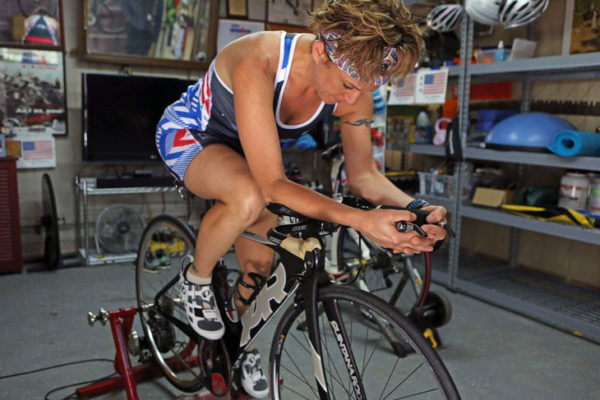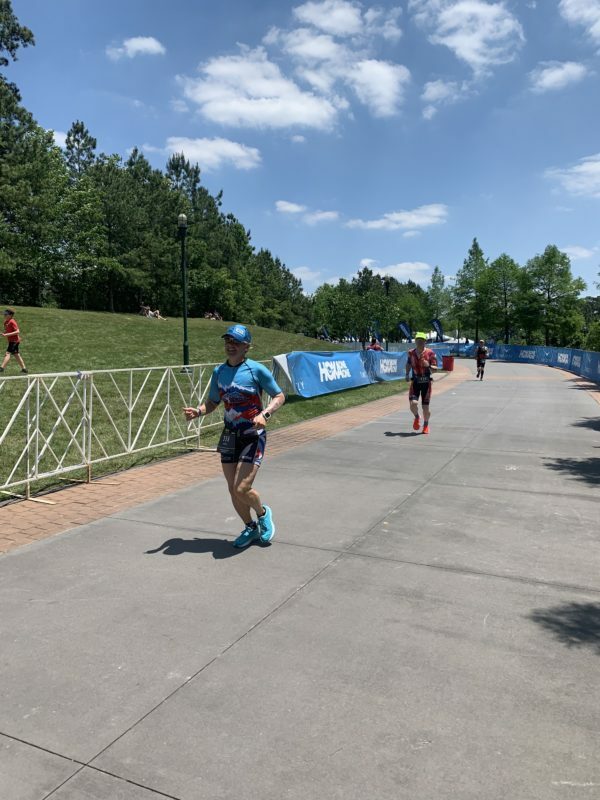~ by Coach Lindsay Leigh
During the 2019 season, I raced at Ironman Texas, which took place at the end of April. I’m not alone – there are more and more triathletes getting their season started earlier by traveling to warmer locations.
For anyone living in the northern part of the world, the weather is the obvious difference between training for an early season triathlon versus a mid or late season race. During my early-season training journey, I discovered several important differences that are worth considering if you plan to do an early-season triathlon.
1. Indoor Training

Let’s start with the obvious: you will have to train inside quite a bit due to temperatures, ice, road conditions, and darkness. About 95% of my bike training was done inside for Ironman Texas. I had a grand total of 2 outdoor rides prior to the race.
We had a snowy, wet winter in Harrisburg, PA, so even when the temps were above 40 degrees, the roads often had ice or salt or cinders covering them, making the trainer the better option. I did some 5 hour bike rides and even a 6 hour bike ride inside.
For athletes who may have bike handling as a limiter, this is a very important consideration. So, even if you can’t get outside for a long ride, you should get out for some shorter sessions that will allow you to work on your skills.
On the plus side, my indoor training allowed me to achieve very race-specific conditions. First, since IMTX is flat, the trainer was an effective, race-specific option for me since I live in a very hilly area and struggle to find routes where I can stay aero and pedal consistently. Second, it was also much warmer inside, and since race day looks to be high of 90, warm was good!
Was it boring? Yep. But 6 hour rides outside can be boring too, especially when done alone which I often do. Inside, at least I can read, watch TV, or listen to podcasts. In this manner, inside rides can be productive, and much safer. I don’t need to worry about getting hit by a car!
Indoor rides prepared my legs well because of the constant pedaling and ability to target my goal race watts for the entire ride. Whereas outside I get to coast down hills a bit, stop at a red lights, and the like. So, these indoor rides provided a challenging and specific training stimulus compared to some outdoor rides.
2. Heat Acclimation

Heat acclimation is another substantial difference when training for an early ironman in a warm climate. Even though most of my training was done inside where it’s ~70 degrees, it doesn’t compare with the 90 degrees and sunny that is typical for race day. So, Coach Maria had me do two rounds of heat acclimation, each lasting 5 days, in the weeks leading up to the race. This was a protocol that has been tested specifically for women, and based on the advice of Dr. Stacy Sims. Men may do a more traditional heat acclimation protocol of 10-14 days continuous, or 3-4 weeks with easy workouts with heat acclimation.
I do not have access to a sauna, otherwise I could’ve sat in there post workouts. My heat acclimation consisted of adding extra layers of clothing on my indoor workouts, and also swimming with a wetsuit in a 82-83 degree pool. So, some of my long rides were done inside with long sleeves, leg warmers, and a hat on. The heat acclimation is designed to increase blood plasma and sweat efficiency. For race day itself, don’t forget your sunscreen!
3. Prep Races
Another big difference in having your first tri of the season being an ironman is you likely will not have the opportunity for a warm up race to shake out the cobwebs from months of not racing tri’s. I like having these “warm up race” to test out equipment, nutrition, gain confidence, and get a nice fitness boost.
In the absence of a prep race, you can schedule in a big day preparation, that includes a swim, bike and run – making for a longer or harder day than your typical training. Depending on your race length, this “big day” can be the equivalent of a sprint, olympic or 70.3 race.
4. Laundry

Another not so obvious difference with training for an early ironman race was the amount of laundry produced. I’m a mom of two young sons so I already do my fair share of laundry.
Yet, this training added more than I expected due to the layers of clothing you need to wear for cold temps, the layers of clothing you need for heat acclimation, the layers of clothing you need to change into for your t-run after your indoor bike (you can’t just throw on your run shoes and run in your sports bra and tri shorts like you can in the summer), and all the sweat towels from your indoor bike and runs sessions.
To save time, sometimes I’d do my t-run on the treadmill just because I didn’t feel like taking the time to change or dirtying up more clothes!
5. Race Weight
Race weight can be a little tougher to get down to over the winter (at least for me!). I thought ironman training would do its job and lean me out to my race weight naturally as it happens in the summer, but I’ve realized that it’s harder for me to lean up over the winter. I’m less active outside of workouts, and I tend to eat more in the cold temps.
If you are looking to achieve an optimal race weight, it will be important to focus on the details of nutrient dense fueling to support your training, while avoiding unnecessary weight gain. (We offer nutrition coaching if you need advice!)
6. Avoiding Germs
Lastly, the hardest part of training for an early season ironman for me was avoiding germs that are so much more prevalent in the winter months. I have 3 and 5 year old sons, and whenever they got sick my body was unable to fight off the germs. In this training cycle, I got a stomach bug and 5 head colds, including one that turned into a bad sinus infection. This illness caused me to miss a few key weeks of training, which was very frustrating.
With heavy training your immune system is already compromised so I was helpless when exposed to those germs. Whenever I’ve trained for ironmans in the summer I’ve gotten maybe one head cold, so this was a big difference. If I ever do this again, I will take steps to build up my immune system with diet and being more of a germaphobe!
Training for an early season ironman when you live where it’s cold and snowy in the winter is absolutely doable but there are some key differences from training in the spring and summer, some positive, and some more challenging. I hope my tips will help you better prepare for that early season ironman!
